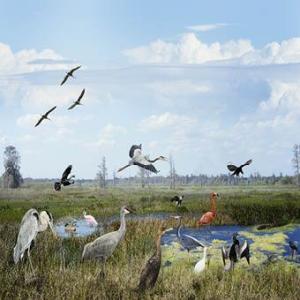Wetland Wednesday
April 22, 2020
How is that for a headline!
Last week on April 15, 2020 a Montana federal district court issued a decision that vacates the US Army Corps of Engineers Nationwide (NW) 12 permit nationally. This permit is used for utility line crossings of wetlands and waterways throughout the United States. This includes oil and gas pipelines, electrical rights-of-way, sewer lines, water lines, telecon, and any other utility type crossing. I do not think I can overstate how big a deal this is.
The case is associated with the rather infamous Keystone XL pipeline project. The specific reason for the case is that the Corps failed to comply with the Endangered Species Act (ESA) because it did not consult with the U.S. Fish and Wildlife Service (FWS) prior to re-issuing the NWP 12 in 2017. Furthermore, there is also an issue related to the Nationwide requirement that an authorized activity, “will result in no more than minimal individual and cumulative adverse effects on the aquatic environment.” The practice of breaking up a project so that segments of it will fit under a Nationwide permit threshold was challenged. This has become common practice for all of the Nationwides and the State Programmatic permits. This could change the applicability of when a Nationwide can be used.
It is expected that the Corps will appeal this decision or a least limit the extent of the decision to Montana. However, the Court did vacate NWP 12 and enjoined the Corps from authorizing any dredge or fill activities under the current NWP 12. They will need to complete the ESA consultation process and be in compliance with other environmental statutes and regulations for the NW12 to be reinstated. But for now, there is no longer a national NW12.
Initial questions as to whether the court’s order applied nationwide or just within the District of Montana were at least temporarily rendered moot. On April 17, 2020 the Corps issued an email directive to all of its chiefs of all Regulatory Districts not to process any more NWP 12 verifications until further notice. However, the email was silent on self certifications. One interpretation is that there was no point in highlighting the permit suspension on cases that where the Corps was not going to assert jurisdiction. In essence no Prior Construction Notification (PCN) is needed. However, their silence on self certifications does not really mean anything. A lot of small pipeline projects operate under the self certification program. I’d ask a lawyer about that one before you assume you have a NW12. (Source: jdsupra.com)
There is a risk in the Corps taking this to court. The basic premise of the case is the lack of coordination with the ESA and the USFWS. I do not think you can limit this lack of coordination to just the NW12. It would seem to be across all of the Nationwides. I am sure that this fact was not missed by the plaintiffs and may be the cause for future litigation.
In addition, the practice of segmenting a linear project to stay under the Nationwide impact thresholds has always been controversial. The project impacts are not aggregated thereby avoiding or reducing mitigation and/or Individual permits. From a bookkeeping point of view this seems to help, but from an environmental impact point of view it would seem to short cut the mitigation. The same holds true for Programmatic Permits that are usually used for State funded projects (like DOT). The entire process is centered around streamlining the permit process. By its very definition it eliminates a lot of inter-agency consultation. This is what the Corps got sued for and lost.
A copy of the decision can be downloaded here.
There is some push back from industry on this decision. On April 20, 2020 North America’s Building Trades Unions (NABTU), the American Petroleum Institute (API) and the Interstate Natural Gas Association of America (INGAA) issued the following statement:
“The US Army Corps of Engineers’ Nationwide Permit 12 is critical to the responsible and efficient development and maintenance of energy and other vital infrastructure projects across America, as well as the millions of good-paying union jobs that they support. Whether it’s a utility line, broadband cable, or a water main, this general nationwide permit allows construction and maintenance activities that will have minimal environmental impacts.
“Based on our initial review, one thing is clear: the judge’s decision to vacate NWP12 went well beyond what the plaintiffs requested. The decision creates tremendous uncertainty in an already uncertain time, and could lead to lengthy delays.”
There is a murky but direct path the Corps may take. The 2017 NWs were due to expire in 2022. There was a movement late last year to expedite the energy related NWs of which NW12 is one. The plan was to publish the new energy NWs in 2020. The Corps may consider publishing all the 2022 NWs two years early rather than try to litigate the 2017 NWs. I am sure they will consult with FWS this time were this to happen. Problem solved. 😉
In other news . . . .
Yesterday, April 21, 2020 the US ACOE and the US EPA published in the Federal Register the FINAL Navigable Waters Protection Rule. This will replace the current 2019 Waters of the US definition and finalize the repeal of the 2015 Clean Water Rule.
There have been some hints at a few court cases poised to strike as soon as this new rule was published. Most of them are a bit weak so time will tell if they will derail the process. In any event the new rule becomes the law of the land on June 22, 2020.
The effect of the new rule is to limit what is considered a federally jurisdictional aquatic resource. The basic test to make a waterbody jurisdictional is to determine its physical connection to a commence connected waterbody. If an aquatic resource lacks this type of connection it is not federally jurisdictional. However, this does not diminish any previously established State or local jurisdiction. Although, there is an argument for some states like New Jersey that have assumed the federal role (CWA 404(g)) that they also lose jurisdiction. If a waterbody (isolated) is no longer a federally regulated, then the states 404(g)assumption of the federal role over an isolated waterbody is no longer applicable. The cure for this is for the state to pass a law (not a regulation) that would define waters of the state.
There are some new technical components that are part of the new Waters of the US definition. The new wetland delineation process now requires the calculation of a typical rainfall year and the determination of perennial and intermittent stream flow. These are two new skill sets that are required for every wetland project.
What week and I did’t even mention COVID once (oops).
So, stay safe and healthy and get ready for a very busy summer.
Happy Earth Day!
Marc

 What you need to do is pick a day between now and next Friday (April 17, 2020) to do your Big Day. Then write down the common names of all the birds you see or hear. It is on the honor system, but you do need to be sure. We don’t need any photographs, just your word is good enough. We are not collecting numbers of individual species, just the bird species itself. So, if you see a cardinal in your back yard 5 times, it will only count once.
What you need to do is pick a day between now and next Friday (April 17, 2020) to do your Big Day. Then write down the common names of all the birds you see or hear. It is on the honor system, but you do need to be sure. We don’t need any photographs, just your word is good enough. We are not collecting numbers of individual species, just the bird species itself. So, if you see a cardinal in your back yard 5 times, it will only count once.